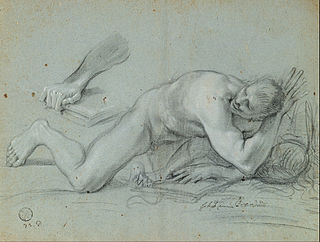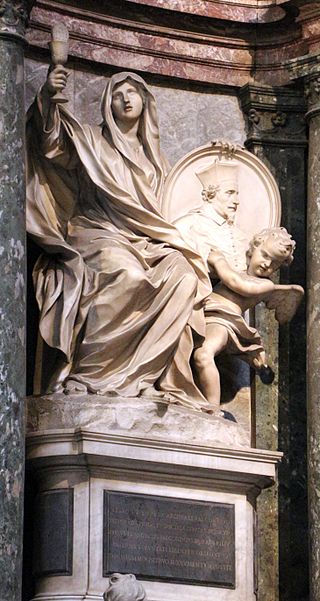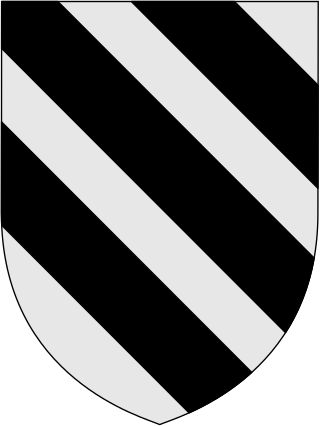
Pietro da Cortona was an Italian Baroque painter and architect. Along with his contemporaries and rivals Gian Lorenzo Bernini and Francesco Borromini, he was one of the key figures in the emergence of Roman Baroque architecture. He was also an important designer of interior decorations.

The Villa Farnesina is a Renaissance suburban villa in the Via della Lungara, in the district of Trastevere in Rome, central Italy. Built between 1506 and 1510 for Agostino Chigi, the Pope's wealthy Sienese banker, it was a novel type of suburban villa, subsidiary to his main Palazzo Chigi in the city. It is especially famous for the rich frescos by Raphael and other High Renaissance artists that remain in situ.

Andrea Sacchi was an Italian painter of High Baroque Classicism, active in Rome. A generation of artists who shared his style of art include the painters Nicolas Poussin and Giovanni Battista Passeri, the sculptors Alessandro Algardi and François Duquesnoy, and the contemporary biographer Giovanni Bellori.

Giovanni Lanfranco was an Italian painter of the Baroque period.

The Palazzo Barberini is a 17th-century palace in Rome, facing the Piazza Barberini in Rione Trevi. Today, it houses the Galleria Nazionale d'Arte Antica, the main national collection of older paintings in Rome.

The Allegory of Divine Providence and Barberini Power is a fresco by the Italian Baroque painter Pietro da Cortona, filling the large ceiling of the grand salon of the Palazzo Barberini in Rome, Italy. Begun in 1633, it was nearly finished in three years; upon Cortona's return from Venice, it was extensively reworked to completion in 1639. The Palazzo, since the 1620s, had been the palatial home of the Barberini family headed by Maffeo Barberini, by then Urban VIII, who had launched an extensive program of refurbishment of the city with art and architecture.

Giovanni Angelo Canini (1609–1666) was an Italian painter and engraver of the Baroque period.

Santa Maria della Pace is a church in Rome, central Italy, not far from Piazza Navona. The building lies in rione Ponte.

Santa Maria in Vallicella, also called Chiesa Nuova, is a church in Rome, Italy, which today faces onto the main thoroughfare of the Corso Vittorio Emanuele and the corner of Via della Chiesa Nuova. It is the principal church of the Oratorians, a religious congregation of secular priests, founded by St Philip Neri in 1561 at a time in the 16th century when the Counter Reformation saw the emergence of a number of new religious organisations such as the Society of Jesus (Jesuits), the Theatines and the Barnabites.

The Villa Pigneto or Sacchetti, or also the Casino al Pigneto del Marchese Sacchetti was a villa in Rome, Italy, designed by the Baroque artist Pietro da Cortona. A second, plainer, Villa Sacchetti, now called Villa Chigi, is found at Castelfusano near Ostia and also was decorated by Cortona.

The Basilica of San Giovanni dei Fiorentini is a minor basilica and a titular church in the Ponte rione of Rome, Italy.

Santi Luca e Martina is a church in Rome, Italy, situated between the Roman Forum and the Forum of Caesar and close to the Arch of Septimus Severus.

Cosimo Fancelli was an Italian sculptor of the Baroque period, active mainly in Rome. He worked on a number of commissions with Pietro da Cortona from 1647 until Cortona's death in 1669. Gian Lorenzo Bernini considered him one of the best sculptors in Rome.

Giulio Cesare Sacchetti was an Italian Catholic Cardinal and was twice included in the French Court's list of acceptable candidates for the Papacy, in 1644 and 1655.

Lelio Falconieri (1585–1648) was an Italian Catholic Cardinal.

Orazio Falconieri was an Italian nobleman from Florence; he was the owner of the Villa Falconieri. His heraldic symbol was a falcon.

The Sacchetti family is an Italian noble family originating in Tuscany, now resident in Rome, whose earliest documented member Merlo lived during the late 10th and early 11th centuries. The name of the family is derived from one or more members known as Sacchetto. According to Ugolino di Vieri (1438–1516),"nobile Sacchetti genus est, moenia primus romanus sangius".

Alessandro Salucci was an Italian painter who played an important role in the development of the genre of cityscapes (vedute) of Rome. He created capricci, i.e. imaginary architectural perspectives and harbour views, in which the figures were often executed by another artist.

Palazzo Sacchetti is a palazzo in Rome, important for historical and artistic reasons.

The Altoviti are a prominent noble family of Florence, Italy. Since the medieval period they were one of the most distinguished banking and political families appointed to the highest offices of the Republic of Florence, friends and patrons of Galileo Galilei, Vasari, Raphael, and Michelangelo. They had a close personal relationship with the papacy. Through a predominant endogamous marriage policy they established alliances with dynasties of principal and papal nobility as the Medici, Cybo, Rospigliosi, Sacchetti, Corsini, and Aldobrandini.




















